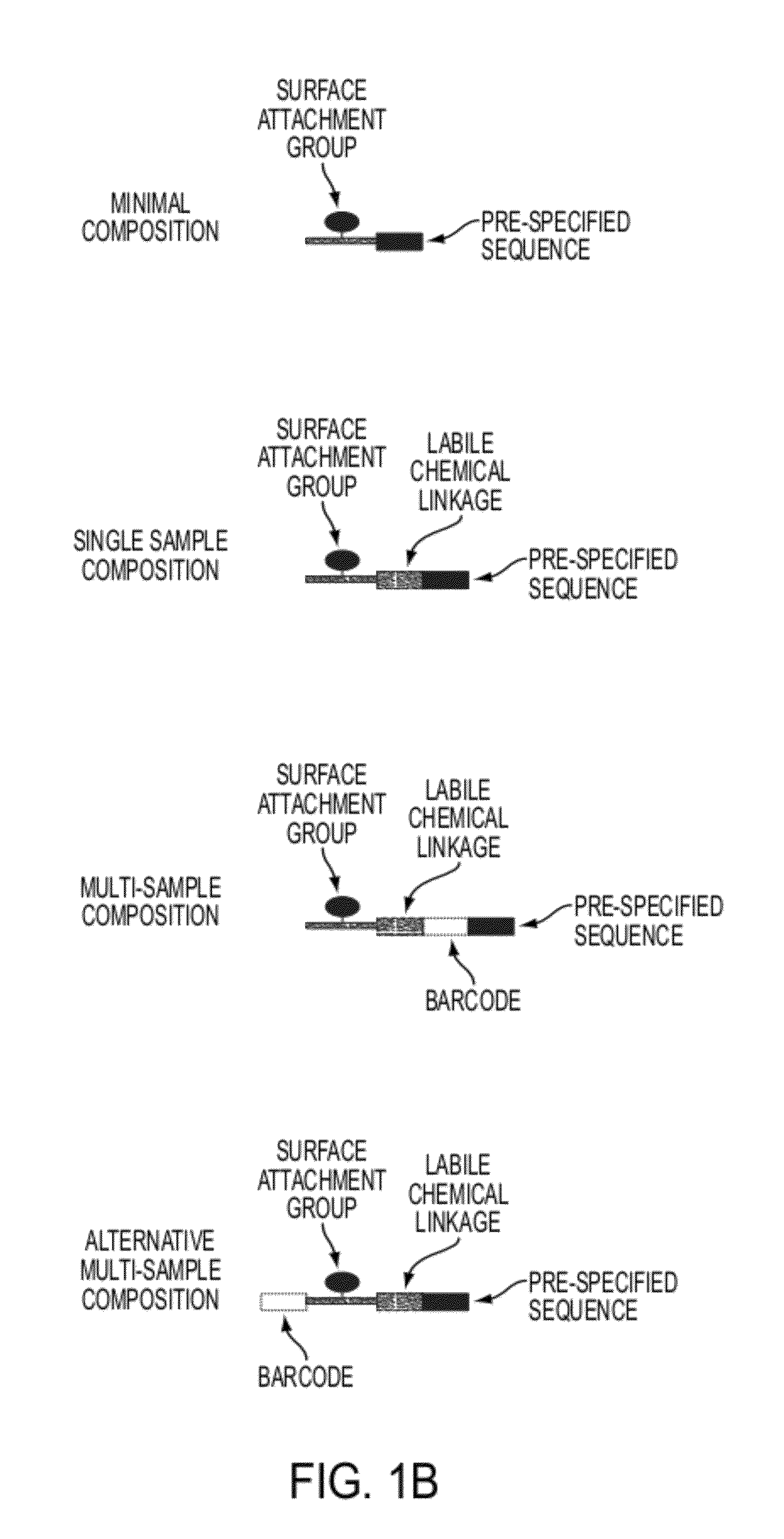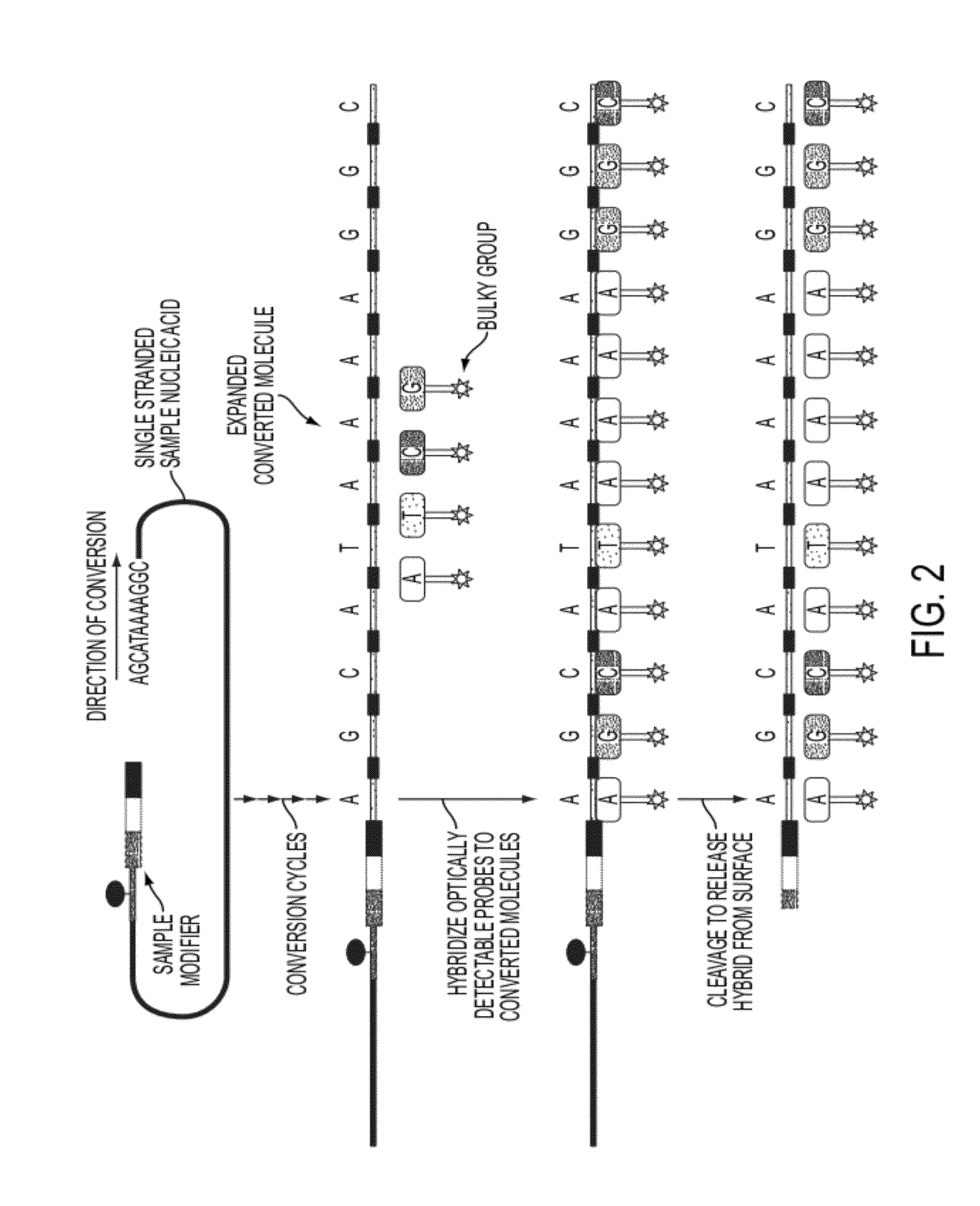Sequence preserved DNA conversion for optical nanopore sequencing
a technology of optical nanopores and dna conversion, which is applied in the identification of library members, nanosensors, biochemistry apparatus and processes, etc., can solve the problems of deteriorating quality for the remainder of the sequence, nanopore sequencing techniques without single nucleotide resolution, and the minimal number of bases that can be resolved by a nanopore has not been firmly established. , to achieve the effect of accurate generation
- Summary
- Abstract
- Description
- Claims
- Application Information
AI Technical Summary
Benefits of technology
Problems solved by technology
Method used
Image
Examples
example 1
Circular DNA Conversion (CDC)
Conversion of a Target ssDNA Target Molecule Starting at its 5′ End
[0259]In this example the conversion process involves a series of hybridization, enzyme incubations and washes all performing on magnetic beads. All the components are commercially available from a variety of sources. Suspend 100 ul of magnetic beads (InVitrogen C1 streptavidin) in a vial. Use magnet to hold beads, and then remove solution. Resuspend beads in 99 ul of bead immobilization buffer (2M NaCl, 2 mM EDTA, 20 mM TRIS, 0.1% Tween). Add 1 ul of biotinylated ssDNA template molecule (Stock conc: 0.5 uM). Leave for 10 mins to allow templates to bind to magnetic beads Use magnet to hold beads, and removed solution. Wash beads 2× with 100 ul Bead immobilization buffer, followed by 2× with 100 ul deionized water. Add 3 ul of probe library (Stock conc: 0.5 uM), 7 ul of Hybridization buffer (50 mM NaCl, 5 mM MgCl2, 10 mM TRIS, 0.1% Tween). Add 7 ul of deionized water, 2 ul of T4 DNA ligati...
example 2
Formation of Kilobase Circular Single-Stranded DNA
[0261]In this example (FIGS. 10A and 10B), 7.4 kB single-stranded, circular M13 phage DNA (M13mp18 cloning vector, NEB) was first digested with 2 restriction enzymes. The restriction enzymes used were BsrGI and AlwNI both available from NEB. Any combination of restriction enzymes might be used to generate fragments of lengths of interest. In order to cut M13 DNA the restriction sites must first be activated by making double-stranded, for this purpose synthetic oligonucleotides were used (20-30 bases) which spanned the restriction enzyme recognition site(s) of interest. For BsrGI the sequenced used was: 5′-AGATGAACGGTGTACAGACCAGGCGC (SEQ ID NO: 2) and for the AlwNI: 5′-ATGGAAAGCGCAGTCTCTGAATTTACCGT (SEQ ID NO: 3). M13 mp18 (10-30 ug) was mixed into NEB Buffer 4, 1.5 molar equivalent of each of the oligonucleotide was added, the mixture heated to 95° C. and cooled to 37° C., approximately 100-200 units of each enzyme added. The digesti...
PUM
| Property | Measurement | Unit |
|---|---|---|
| Length | aaaaa | aaaaa |
| Magnetism | aaaaa | aaaaa |
Abstract
Description
Claims
Application Information
 Login to View More
Login to View More - R&D
- Intellectual Property
- Life Sciences
- Materials
- Tech Scout
- Unparalleled Data Quality
- Higher Quality Content
- 60% Fewer Hallucinations
Browse by: Latest US Patents, China's latest patents, Technical Efficacy Thesaurus, Application Domain, Technology Topic, Popular Technical Reports.
© 2025 PatSnap. All rights reserved.Legal|Privacy policy|Modern Slavery Act Transparency Statement|Sitemap|About US| Contact US: help@patsnap.com



